MVHR (Mechanical Ventilation Heat Recovery) systems, sometimes referred to as whole house ventilation systems, are getting a higher profile in domestic properties as their value in improving energy efficiency, removing stale moist air and in some cases filtering pollen and other airborne dust is recognised. This article explains what they do, what the components of a Mechanical Ventilation Heat Recovery System are and the reasons for their growing popularity in new and existing homes.
What does an MVHR system do?
An MVHR system removes moist stale air and delivers fresh air to a property, in an energy efficient way.
It works by extracting warm, moist air from around the home, putting it through a heat exchanger to extract the heat and then expelling the air to the outside. At the same time it takes fresh generally colder air from the outside and uses the heat from the heat exchanger to warm the incoming fresh air before delivering it around the house. Typically stale air would be removed from kitchens, bathrooms and toilets and fresh air would be introduced into living and sleeping areas such as lounges and bedrooms.

The system allows you to control the speed with which air is changed in a house, without relying on extractor fans or opening and closing windows. The system can be managed using a control panel possibly linked to humidity or carbon dioxide sensors or boost switches. The system can increase the speed of air changes if a bathroom reaches a specific level of humidity because someone is showering. The system can be given a manual boost to clear cooking smells more quickly.
Couldn’t I just open the windows or use an extractor fan?
The simple answer is yes but the MVHR system allows you to control moisture and air changes throughout the day without losing a lot of heat energy. On a cold day you don’t really want all that lovely warm expensively heated air to disappear out the window or through the extractor fan.
A wider consideration is that having fresh air is too important for people’s health to leave it to chance. Older houses rely on draughts and the opening of windows and doors to get fresh air in. As homes become more and more insulated then the draughts are reduced but this also reduces the opportunity for moist stale air to be changed and replaced; the result can be the build up of damp and condensation. A MVHR system can help address this.
Components of a Mechanical Ventilation Heat Recovery System
The basic components are:
- Air inlet and outlets to the outside
- Heat exchanger
- Ducts to connect the system elements together
- Inlet vents in the ceilings of kitchen’s bathrooms and toilets
- Outlet vents in the ceilings of living rooms and bedrooms
- Control panel to manage system functions
- Sensor inputs: humidity or carbon dioxide
- Boost switch for removal of cooking smells
Lets take a look at each in turn.
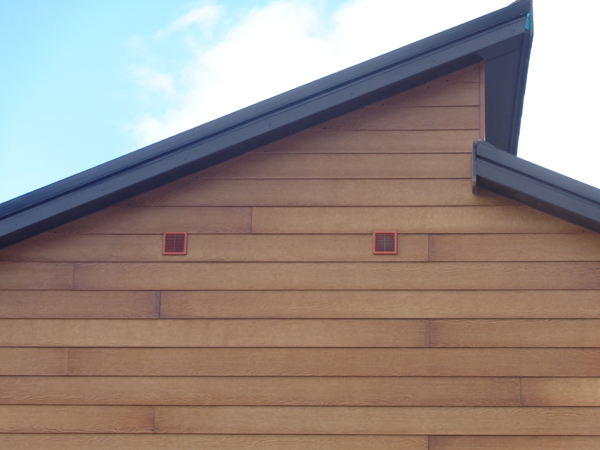
Ductwork leads from the inlet and outlet to the heat exchanger
The inlet vent for a Mechanical Ventilation Heat Recovery system should ideally be about 2 metres away from the outlet and well away from a boiler flue.
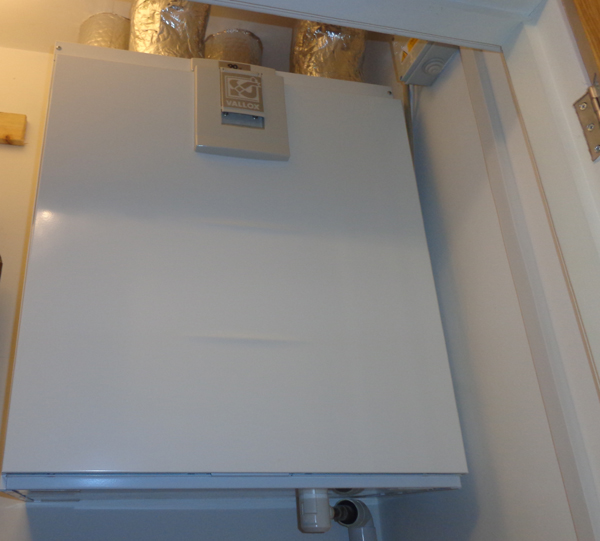
The unit also has fans and filters to distribute air
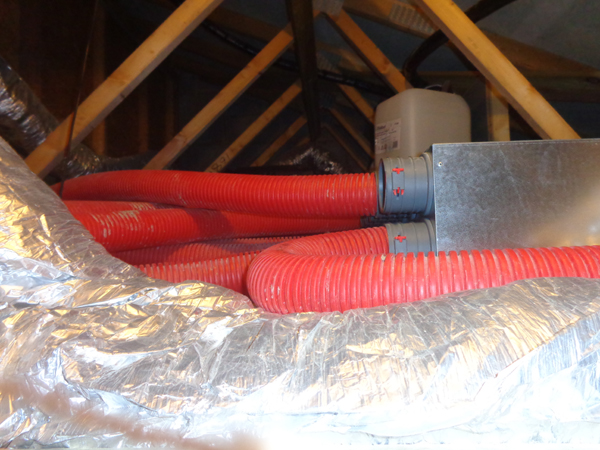
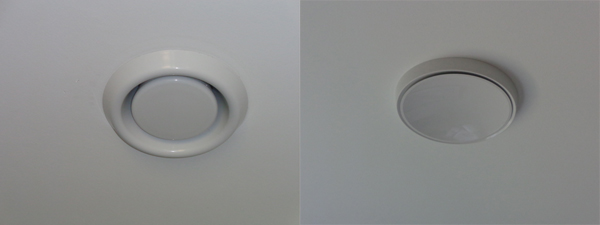
The left hand vent extracts stale moist air from a room whilst the right hand vent pushes warm fresh air into a room
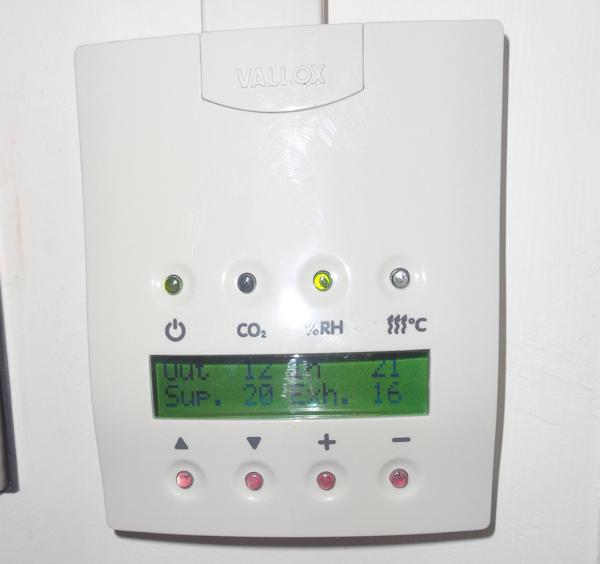
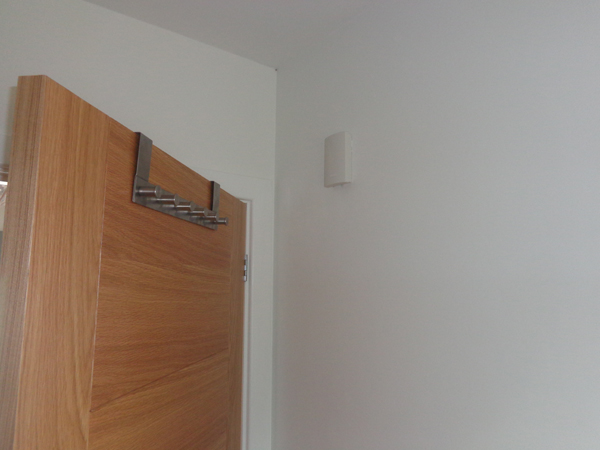
As humidity rises in the bathroom then the fan speed of heat exchanger unit increases to clear moisture quickly.
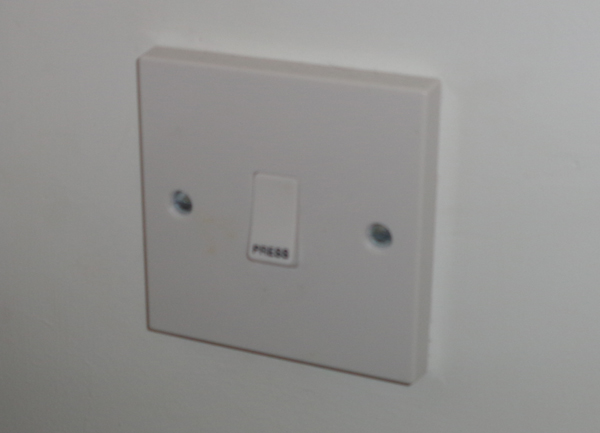
When pressed it switches the heat exchange unit to maximum fan speed for 30 minutes.
Why are MVHR systems more common now?
Best practice in building has changed over the years. Nowadays highly energy efficient buildings (such as a Passivhaus) can be thought of as water and air tight well insulated boxes with little “natural” ventilation. An MVHR system is a key element of this type of energy efficient building which can use a fraction of the energy used on space heating in a typical house (20% or less of what it costs to heat a typical house).
Traditional houses were not designed to be water or airtight. They were often built with solid walls so rain falling on the outer skin of the house could find its way to the inside. To make sure that damp did not build up there was often lots of natural ventilation (otherwise known as cold draughts) through the floors, windows, doors and roof. Despite this some more traditional homes still suffer from damp and mould due to lack of adequate ventilation. As energy costs have risen and people want more comfort the trend has been towards increased insulation measures, cutting natural ventilation and creating more damp and condensation problems. Some traditional homes, often those that are having a major renovation, have an MVHR system included as part of the upgrade. This allows insulation to be improved and can also help tackle problems with damp and condensation.
What are the benefits of an MVHR system?
An Mechanical Ventilation Heat Recovery system can:
- provide high quality fresh air throughout the building
- reduce dust and pollen throughout the house (with a system with an F7 inlet filter)
- reduce moisture and smells generated by washing and cooking
- reduce energy usage in homes with air leakage below 3m³/(h.m²) at 50Pa
What does an MVHR system cost to maintain?
It is generally recommended to clean or change the filters in the MVHR unit once or twice a year. This is quite a simple task to do and would take around 15 minutes. Depending on the unit, replacement filters will cost around £25 so replacing twice a year would cost £50 plus any labour costs.
What is the air quality like with an MVHR system?
MVHR systems provide a high quality of air throughout the home. As the air is filtered before being distributed it also tends to be dust free. It does depend on the unit but the Vallox 90SE has two filters on the inlet and one on the outlet. The inlet filter is a G3 and then an F7 filter. There is also a G3 filter on the exhaust air. The G3 is a filter for coarse particles and dust whilst the F7 is for finer particles. Hay fever suffers should benefit from pollen being filtered out of the air.
Are there any things to watch out for on installation?
It is important that the system is installed in line with the manufacturer’s instructions and latest best practice.
- Where ducting or other parts of the system run outside of the insulated area of the building, such as in an unheated roof space, then components should be well insulated. The air distribution boxes shown in the roof space picture have not been insulated, resulting in heat loss and colder air being piped into living areas.This was remedied using space blanket insulation covering the entire unit.
- When using semi-rigid ducting it is important that this is not compressed. A heavy boot or two treading on the ducting can squash it, reducing its capacity to distribute air.
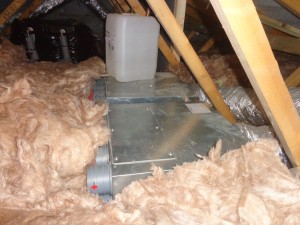
Hi Jon
if you were building a brand new house and money was no option what systems would you use to be most energy efficient and green?
Hi Victoria,
Personally I would love to build a house with hempcrete walls – a mix of hemp and lime – which would lock carbon into the building fabric and provide excellent thermal insulation whilst allowing moisture movement through the walls. A building that used passive elements rather than active ones i.e. passive cooling by designing air flow in the right places. The building should ideally not need space heating at all abut could also be relatively cool in the summer.
Not many people get the opportunity to build from scratch though!
Kind regards
Jon
Hi Jon I’ve been looking at this system but there are a couple of doubts.
First – I’ve been told that moist air is simply taken into the loft and then removed by the natural air currents which derive from gaps in tiles etc. Fresh air is introduced into the loft from outside and is directed back into the house. This doesn’t sound very clever to me and I don’t really see how it can work. I would have certainly have expected the inclusion of ducting.
Second, and further to the first point, I noticed condensation on the roofing felt in my loft this last winter. I’ve never noticed it before (although that doesn’t necessarily mean that it wasn’t there), but this does reinforce my previous point.
Hi Pete,
Thanks for the queries. On point 1, the system expels the moist air to the outside with ducting, not into the roofspace. MVHR systems will have ducting on both inlet and outlet to the outside – see Figure 2 for an example of external vents that the ducting is typically connected to.
On point 2, condensation on roofing felt will likely be down to either poor ventilation within the roof space or excess moisture from the home (often through gaps in loft hatches or from gaps where recessed halogen lights have been installed in bathroom ceilings) or from leaks in the roof itself.
Hope this clarifies.
Kind regards
Jon
Can I get government help with the cost of installing MVHR heat recovery systems for my house?
Hi John,
Not that I am aware of. The main grant activity at the moment is the Green Home Grant which do not, as far as I am aware, cover MVHR or other ventilation aspects. See https://great-home.co.uk/home-insulation/ for details on what is covered.